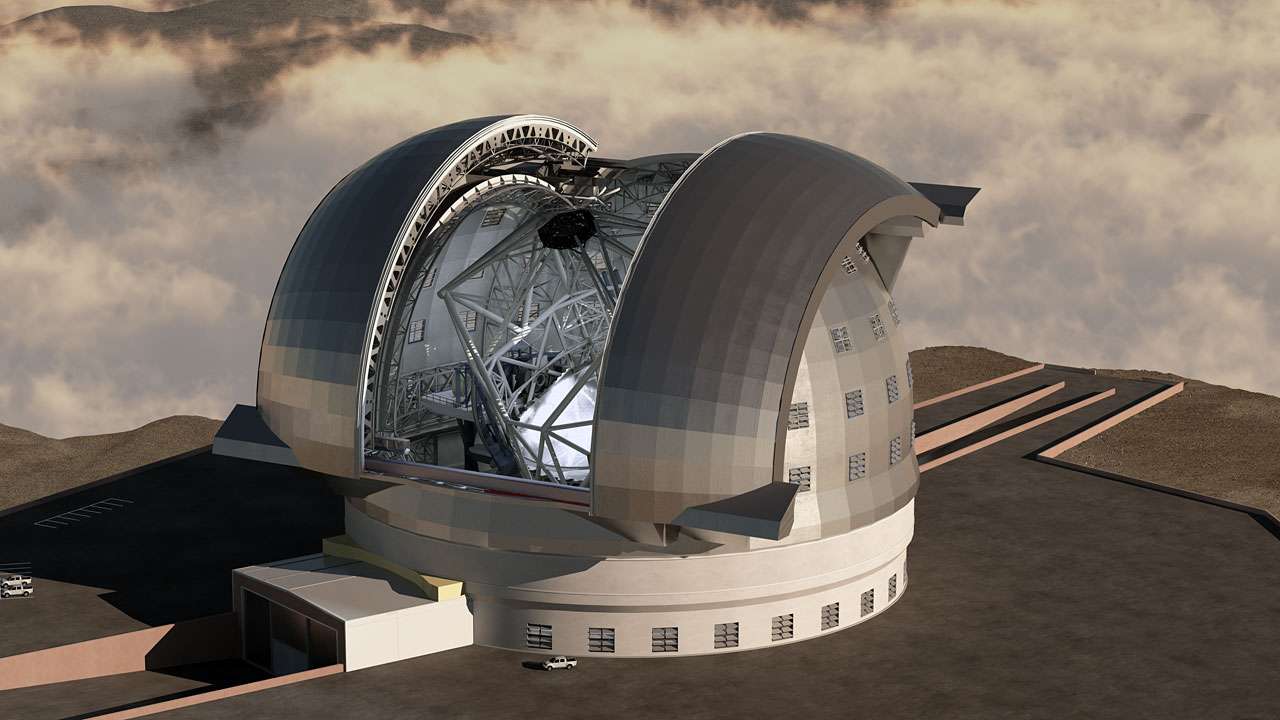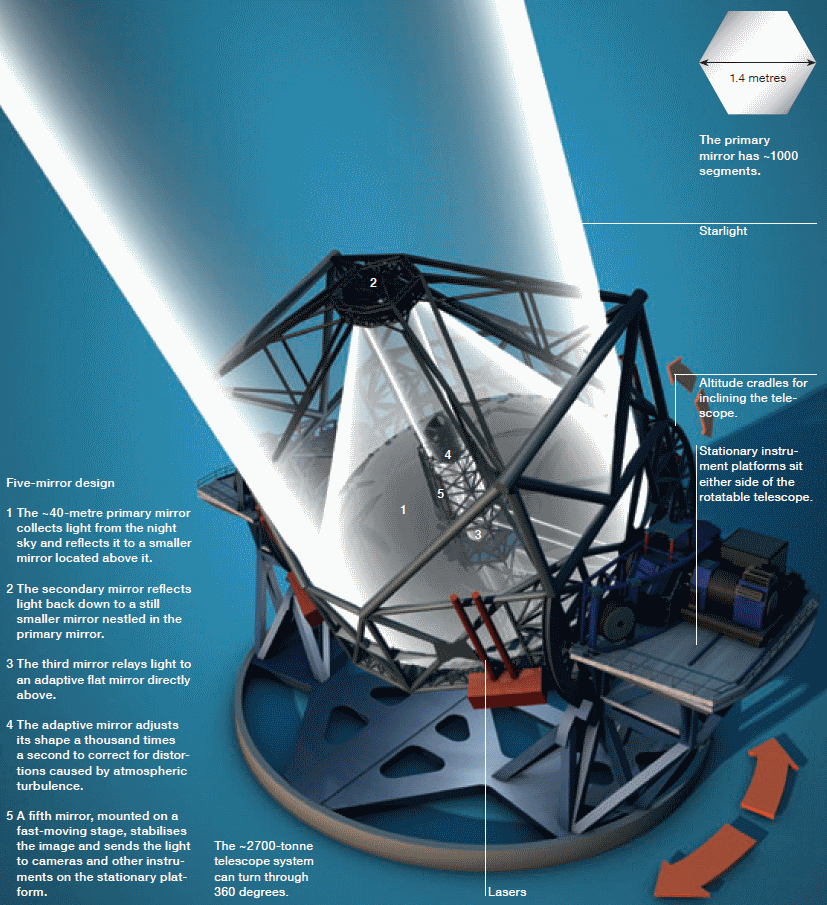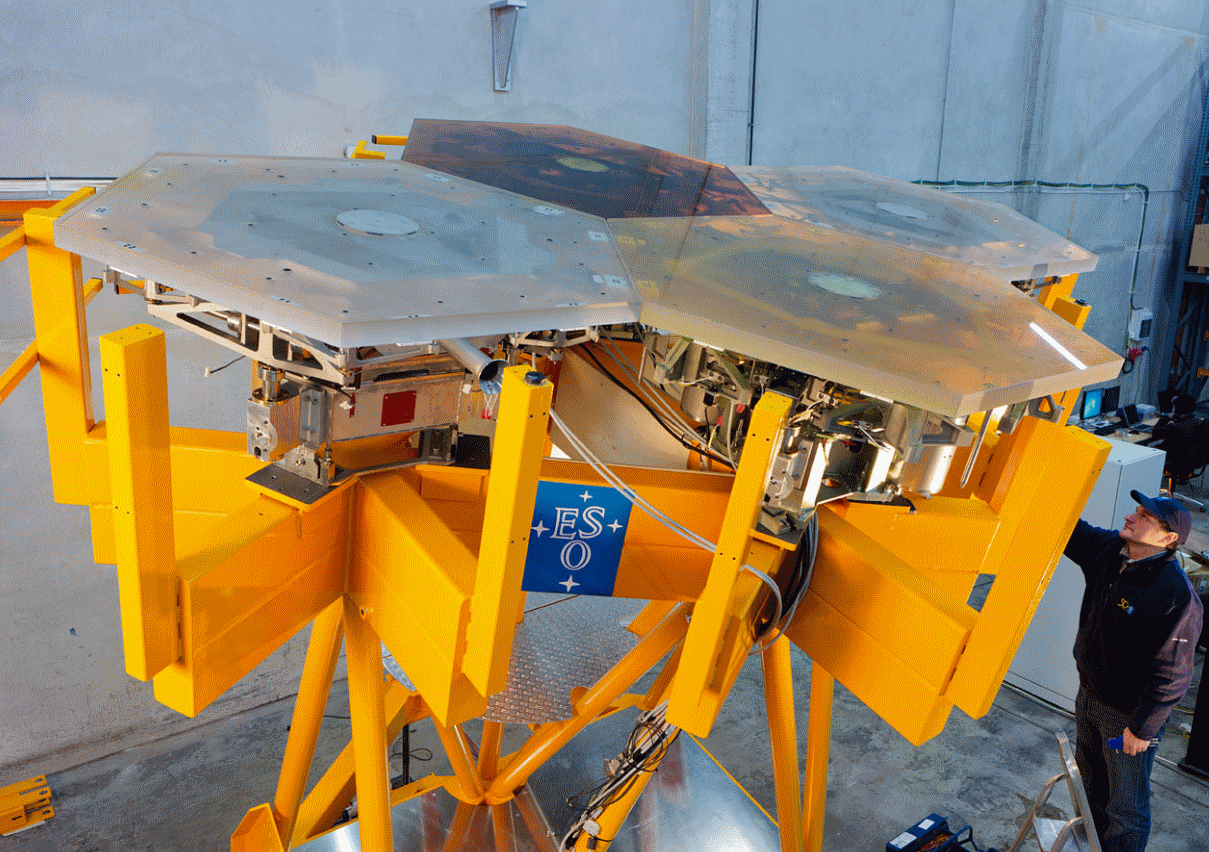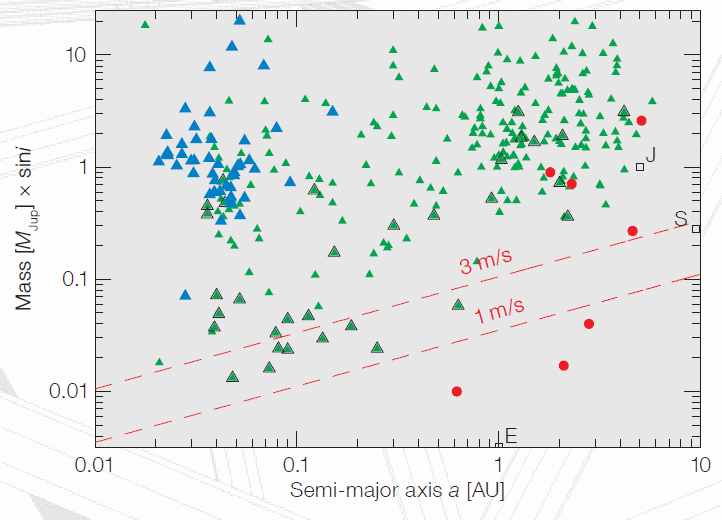It looks like you're using an Ad Blocker.
Please white-list or disable AboveTopSecret.com in your ad-blocking tool.
Thank you.
Some features of ATS will be disabled while you continue to use an ad-blocker.
21
share:
The telescope that will be able to detect life outside our solar system in 2020
Yes, you read it right... and it's not science-fiction as its construction has already begun.
Before explaining how this over-sized telescope will be able to detect life, let's briefly talk about its history.
History
In December 2004, the ESO Council decided to build very large telescopes (Extremely Large Telescopes), to make Europe the leader in the field of astronomy. Quickly, a feasibility study was launched on a telescope with a mirror diameter of 100 meters, the Overwhelmingly Large Telescope (OWL).

In October 2005, the "Blue-Book OWL report" confirms the technical feasibility of achieving such an observation instrument. But, rather, advise to make smaller telescopes, with a diameter primary mirror of 30 to 60 meters, whereas the complexity and budgetary drift inherent in such companies would be better controlled.
In December 2005, the project is entering a phase of consultation with the international astronomical community, to define the characteristics of the telescope. Five groups are trained to study every aspect of the telescope (scientific interest, necessary tools, evaluation and highlighting possible siting, design and study of the telescope and its adaptive optics). During the summer of 2006, reports of each group are given at ESO. These reports advise that the ELT (European Extremely Large Telescope) is able to observe in the visible and infrared.

This picture was taken at ESO’s Garching Headquarters during the historic Council meeting of 11–12 June 2012 when the E-ELT programme was approved (subject to confirmation of the so-called ad referendum votes)
June 1, 2006, Dr. Jason Spyromilio is officially designated as Project Director of the E-ELT.
December 11, 2006, members of the ESO decided to launch studies prior to construction of the E-ELT. The expected diameter of the mirror is 39 meters, for a total cost of the device estimated between 800 million and 1 billion €.
In March 2010, the selection committee recommended the Cerro Armazones, near Cerro Paranal, the site of this future télescope.
The Board of ESO, in April 26, 2010 has officially selected the site of Cerro Armazones.
October 16, 2011, an agreement was signed between Chile and ESO for the endowment of land and the creation of a protected area. The start of construction is scheduled for 2011 and the first operations are planned for the beginning of the next decade. In June 11, 2012 the ESO Council endorsed at its meeting in Garching, the construction of the ELT and its first batch of instruments. Construction of road and leveling to begin this year.

A new architectural concept drawing of ESO’s planned European Extremely Large Telescope (E-ELT) shows the telescope at work, with its dome open and its record-setting 40-metre-class primary mirror pointed to the sky. In this illustration, clouds float over the valley overlooked by the E-ELT’s summit. The comparatively tiny pickup truck parked at the base of the E-ELT helps to give a sense of the scale of this massive telescope. The E-ELT dome will be similar in size to a football stadium, with a diameter at its base of over 100 m and a height of over 80 m.
How it works?
The primary mirror (M1) of the ELT use the technique of segmented mirror, which is to break it into several "small" mirrors. The ELT will consist thus of 798 hexagonal elements of 1.45 m diameter. Assembled as those of the two Keck telescopes in Hawaii, they will reach a total area of 1116 square meters, 39.3 meters in diameter, with a mass of 150 tons.
The light received by the mirror M1 is returned to the mirror M2 (6 meters in diameter), then to the mirror M3 (4.2 meter diameter), the mirror M4 (2.5 meters diameter) and finally the mirror M6 (2.7 meters in diameter) that stabilizes the image and returns to the measuring instruments.

The E-ELT five mirrors principle
The telescope will have lasers that simulate artificial stars and used to correct the mirrors M1 and M4.
Due to the large mass of the telescope, the mirror M1 is supported by 30,000 iron segments that will correct in real time the forces due to bending and deformation caused by the wind and the rotation of the mirror.
The mirror M4 ELT will also have adaptive optics: it will be able to correct in real time turbulence due to weather conditions. To do this, the mirror will be placed on 7000 actuators that deform the mirror 1000 times per second.

Four segments of the giant primary mirror of the E-ELT undergoing testing together for the first time.
Exoplanets — Towards other Earths
With the E-ELT, for the first time in history, technology allows us to observe and to characterise exoplanets in habitable zones.
The first exoplanet orbiting a solar-type star (51 Pegasi) was discovered in 1995 by a European team. Since then, over 400 planetary companions with masses ranging from a few Earth to several Jupiter masses have been found. Most exoplanets are detected indirectly by the radial velocity technique, a method that detects planets by the “wobble” they produce on their parent star as they orbit it. However, such indirect detections only allow us to infer very limited information about the planet itself, and very few direct observations of planets have been made.

Artist's impression of the trio of super-Earths discovered by an European team using the HARPS spectrograph on ESO's 3.6-m telescope at La Silla, Chile, after 5 years of monitoring. The three planets, having 4.2, 6.7, and 9.4 times the mass of the Earth, orbit the star HD 40307 with periods of 4.3, 9.6, and 20.4 days, respectively.
The E-ELT will be able to obtain direct images of some of these systems, including planets in the “habitable zones”, where a rocky planet might hold liquid water on its surface.
edit on 12-12-2012 by elevenaugust because: (no reason given)
edit on 12-12-2012 by elevenaugust because: (no reason
given)
The radial velocity technique
The E-ELT will gather 100 000 000 times more light than the human eye, 8 000 000 times more than Galileo's telescope, and 26 times more than a single VLT Unit Telescope. In fact, the E-ELT will gather more light than all of the existing 8–10-metre class telescopes on the planet, combined...
Direct imaging — approaching 10–9 contrast
Characterising atmospheres
Sources
- ESO
- ESO EELT Science case
- Wiki
I'm particularly interested in these two lasts techniques as, if an intelligent civilization have successfully evolved to produce light on its planet, it should be detected theoretically by the E-ELT...
Detection Technique for Artificially-Illuminated Objects in the Outer Solar System and Beyond
As for the detection of complex/organic (chlorophyll for example) molecules in exoplanets atmospheres, there's no doubts that E-ELT will be able to detect them and then change our vision of the Universe.
The radial velocity technique, which measures the induced Doppler shift of features in the spectrum of the parent star, can only find certain kinds of planets. With the current generation of telescopes, this technique is limited both by the precision and the stability of the velocity measurements: current measurements have pushed the limit down to an already impressive ~1 m/s precision retained over several years.
Unfortunately, though, a planet like the Earth, orbiting a star like the Sun, will only induce a radial velocity of about a tenth this size, which lies at the limit of what can be achieved with even the next generation of instruments on current telescopes. In contrast, ultra-stable spectrographs profiting from the large collecting power of the E-ELT will achieve measurement precisions of ~1 cm/s over periods ranging from minutes to years. For the detection of rocky planets in habitable zones, this precision is needed in order to overcome measurement contamination by oscillations, seismology, granulation and magnetic activity of the parent star.
More than 400 exoplanets have been found so far. With the E-ELT, the sensitivity of the radial velocity method will be improved by a factor of one hundred.
Thus, the E-ELT is essential for finding Earth twins in habitable zones, for determining how common they are and for understanding the properties of their parent stars. This will allow a complete census of rocky Earth- to Neptune-mass planets around nearby stars for the first time and will provide an understanding of the architecture of planetary systems with low-mass planets. These studies will lead to an understanding of the formation of Solar System twins and will provide an answer to an important part of the fundamental question: just how unique are we?
The E-ELT will gather 100 000 000 times more light than the human eye, 8 000 000 times more than Galileo's telescope, and 26 times more than a single VLT Unit Telescope. In fact, the E-ELT will gather more light than all of the existing 8–10-metre class telescopes on the planet, combined...
Direct imaging — approaching 10–9 contrast
By 2020, ground- and space-based facilities will have discovered thousands of massive (Neptune- and Jupiter-mass) exoplanets. The E-ELT will start detecting Earth-twin targets in habitable zones using the radial velocity technique described above. By then, the statistical understanding of the properties of the parent stars and the distributions of the masses and orbits of exoplanets will have matured. The next step in exoplanet research will be the physical characterisation of the then known planets.
An artist’s view of the exoplanet CoRoT-7b, the closest known to its host star. The role of the E-ELT is to characterise similar rocky planets, but in habitable zones.
In order to achieve this, direct light from the planet must be detected and separated from the glare of its parent star. Overcoming this difference in brightness (usually referred to as the contrast) is the main challenge for this type of observation, and requires extremely sharp imaging. This capability will be a huge strength of round-based telescopes. Planet-finder instruments on 8-metre-class telescopes will achieve similar contrasts to the James Webb Space Telescope: around 10–5 to 10–6 at sub-arcsecond distances from the parent stars.
The detection of an Earth-twin requires a contrast of 10–9 or better within less than 0.1 arcseconds from the star. The unprecedented light-gathering power of a 40-metre-class telescope, and the implementation of extreme adaptive optics in the E-ELT are absolutely crucial to reaching this limit.
Characterising atmospheres
With the E-ELT, the detailed study of the atmospheres of young, massive exoplanets becomes feasible. Indeed, with its unprecedented sensitivity and spatial resolution at mid-infrared wavelengths, the E-ELT will be able to detect young, self-luminous exoplanets of Jupiter-mass. The contrast ratio between star and planet at these wavelengths becomes so advantageous that, for the nearest stars, hydrogen, helium, methane, water ammonia and other molecules can all be detected in low resolution spectra of the atmospheres of Neptune-like planets in habitable zones.
Using the Hubble Space Telescope astronomers have found water vapour and methane in the atmosphere of the Jupiter-sized planet HD 189733b.
Alternatively, exoplanet atmospheres can be observed during transits. Ground- and space-based facilities (such as the CoRoT and Kepler missions) are accumulating target stars for which an exoplanet, as seen from Earth, transits in front of its parent star. During these events (lasting a few hours every few months or years), spectral features of the exoplanet’s atmosphere, back-lit by their parent star, can be seen in the spectrum of the system. Such measurements are challenging, but lie within reach of the E-ELT. In the case of rocky planets in the habitable zone, the spectra can be examined for the biomarker molecules that are indicative of biological processes, offering perhaps the best opportunity to make the first detection of extraterrestrial life.
Sources
- ESO
- ESO EELT Science case
- Wiki
I'm particularly interested in these two lasts techniques as, if an intelligent civilization have successfully evolved to produce light on its planet, it should be detected theoretically by the E-ELT...
Detection Technique for Artificially-Illuminated Objects in the Outer Solar System and Beyond
A new study suggests that astronomers could soon look for city lights on distant worlds. Astronomical campaigns already in the works, for instance, could spot a large illuminated city as far away as the Kuiper Belt, where Pluto and many other icy worlds orbit.
Artificial illumination on a Kuiper Belt Object would stand out because it would vary less than reflected sunlight does when the world moved toward or away from the sun.
“Just by checking for how their brightness varies with distance, you would be able to identify interesting candidates.”
Princeton's Edwin Turner, a co-author of the new study. Unfortunately, Turner says, no telescopes currently in the works would be powerful enough to identify city lights in other planetary systems. Unless the aliens like things really bright.
“Forthcoming facilities might be able to see artificial lighting on another world if it’s really much brighter than we use. It begins to become plausible that we could detect it. A million times would be for sure, and 10,000 times we might have a chance.”
As for the detection of complex/organic (chlorophyll for example) molecules in exoplanets atmospheres, there's no doubts that E-ELT will be able to detect them and then change our vision of the Universe.
edit on 12-12-2012 by elevenaugust because: spelling
Awesome!
To me this implies that an intelligent alien civilization needs only to be a decade or so more advanced than us to all ready be imaging US!
Wow!
To me this implies that an intelligent alien civilization needs only to be a decade or so more advanced than us to all ready be imaging US!
Wow!
edit on 12-12-2012 by tjack because: (no reason given)
I hope whatever ET we come across in the future has a sense of humor.
Our only shot is if they are willing to laugh at us.
Also, a thought I sometimes have is our primary means of detection being light. It could be possible that there is some way of looking at the universe more efficient. As it is, we only see a small range of the spectrum. Obviously, these telescopes have enhanced capabilities but there may be life with some other primary sense, maybe even one that relies on particles yet undiscovered.
Our only shot is if they are willing to laugh at us.
Also, a thought I sometimes have is our primary means of detection being light. It could be possible that there is some way of looking at the universe more efficient. As it is, we only see a small range of the spectrum. Obviously, these telescopes have enhanced capabilities but there may be life with some other primary sense, maybe even one that relies on particles yet undiscovered.
edit on 12/12/2012 by PatrickGarrow17 because: (no reason
given)
So we have the Very Large Telescope...
and the Extremely Large Telescope...
and the Overwhelmingly Large Telescope...
What's next? the Incredibly Awesomely Large Telescope?
The Unbelievably Large Telescope?
Or maybe the "FMHT" --- The F***ing Monstrously Huge Telescope.
and the Extremely Large Telescope...
and the Overwhelmingly Large Telescope...
What's next? the Incredibly Awesomely Large Telescope?
The Unbelievably Large Telescope?
Or maybe the "FMHT" --- The F***ing Monstrously Huge Telescope.
edit on 12/12/2012 by Soylent Green Is People because: (no reason given)
Originally posted by PatrickGarrow17
I hope whatever ET we come across in the future has a sense of humor.
Our only shot is if they are willing to laugh at us.
Also, a thought I sometimes have is our primary means of detection being light. It could be possible that there is some way of looking at the universe more efficient. As it is, we only see a small range of the spectrum. Obviously, these telescopes have enhanced capabilities but there may be life with some other primary sense, maybe even one that relies on particles yet undiscovered.edit on 12/12/2012 by PatrickGarrow17 because: (no reason given)
have you ever heard of radio telescopes?
reply to post by stirling
Yeah, radio waves are part of the same spectrum of electromagnetic radiation. I was speculating along the lines that there may be some methods which people are not aware of, or capable of detecting. I think life has a much wider variety than is generally believed by just observing Earth. We assume that ET will share so many characteristics with Earth based life- like water, and electromagnetic based tech. Not necessarily true.
Yeah, radio waves are part of the same spectrum of electromagnetic radiation. I was speculating along the lines that there may be some methods which people are not aware of, or capable of detecting. I think life has a much wider variety than is generally believed by just observing Earth. We assume that ET will share so many characteristics with Earth based life- like water, and electromagnetic based tech. Not necessarily true.
Is this not old news, I've known about this for years it been on the BBC and space.com tons of times and I'm sure on here... I dunno cheers for the
round up through!
Originally posted by tjack
Awesome!
To me this implies that an intelligent alien civilization needs only to be a decade or so more advanced than us to all ready be imaging US!
Wow!edit on 12-12-2012 by tjack because: (no reason given)
Exactly and how about a few centuries or millenia ahead of us? well they have been watching us from the comfort of whatever passes for a lounge chair on their world for a very, very long time.
This is great news
Its the first ive heard so thanks for the heads up OP
Europe is really pushing it in Technology in recent years with the LHC and now the Large Telescope life detector
Well we all know you'd have to be an absolute idiot to bet against them, finding another earth can't wait for the "Official" news
Its the first ive heard so thanks for the heads up OP
Europe is really pushing it in Technology in recent years with the LHC and now the Large Telescope life detector
Well we all know you'd have to be an absolute idiot to bet against them, finding another earth can't wait for the "Official" news
Hopes and dreams need legs to run, and the US just made legs illegal.
Sorry, just been on the down lately. This is great, but even if we build the telescope in 2020, the people looking into the telescope will be paid to say, "Nah, nothing out there yet."
Job security and budget justification. Again, this is awesome, but it just won't happen, imo.
I thought SETI was doing the same already?
Lima-1, out.
Sorry, just been on the down lately. This is great, but even if we build the telescope in 2020, the people looking into the telescope will be paid to say, "Nah, nothing out there yet."
Job security and budget justification. Again, this is awesome, but it just won't happen, imo.
I thought SETI was doing the same already?
Lima-1, out.
edit on 13-12-2012 by OperationIraqiFailure because: (no reason given)
Originally posted by OperationIraqiFailure
Hopes and dreams needs legs to run, and the US just made legs illegal.
Sorry, just been on the down lately. This is great, but even if we build the telescope in 2020, the people looking into the telescope will be paid to say, "Nah, nothing out there yet."
Job security and budget justification. Again, this is awesome, but it just won't happen, imo.
I thought SETI was doing the same already?
Lima-1, out.
All SETI is does is listens for radio signals.
Originally posted by Soylent Green Is People
Originally posted by OperationIraqiFailure
Hopes and dreams needs legs to run, and the US just made legs illegal.
Sorry, just been on the down lately. This is great, but even if we build the telescope in 2020, the people looking into the telescope will be paid to say, "Nah, nothing out there yet."
Job security and budget justification. Again, this is awesome, but it just won't happen, imo.
I thought SETI was doing the same already?
Lima-1, out.
All SETI is does is listens for radio signals.
Aren't both methods "looking for ET," though? My main point is that even if "we" find ET, "they" won't tell us. I only say "we" because We the People pay to have these things built, only to have the information stolen from us, in the name of National Security.
Lima-1, out.
Originally posted by Soylent Green Is People
So we have the Very Large Telescope...
and the Extremely Large Telescope...
and the Overwhelmingly Large Telescope...
What's next? the Incredibly Awesomely Large Telescope?
The Unbelievably Large Telescope?
Or maybe the "FMHT" --- The F***ing Monstrously Huge Telescope.
edit on 12/12/2012 by Soylent Green Is People because: (no reason given)
You put it so well Soylent.
What's the purpose of this monster other than to be used by scientists only to tell us they need a BIGGER, BETTER, FINER, or whatever kind of telescope.
They always end up referring to Hubble anyway.
Unless, Hubble crashes down to Earth...
How long must we wait for the stupendiscope ? Seriously , this is cool . It burns my buns a little when the Europeans outshine us , but not enough
that science doesn't win out .
My big dream is to link a few huge telescopes together , and not side by side but far apart , 20 or 30 would be lovely . ( yes I know , but just thinking about it is making me giddy ) Last time I looked it was supposed to be harder than it sounds but equipment is getting better all the time . I'm looking forward to seeing what this thing can do .
My big dream is to link a few huge telescopes together , and not side by side but far apart , 20 or 30 would be lovely . ( yes I know , but just thinking about it is making me giddy ) Last time I looked it was supposed to be harder than it sounds but equipment is getting better all the time . I'm looking forward to seeing what this thing can do .
new topics
-
Happy St George's day you bigots!
Breaking Alternative News: 1 hours ago -
TLDR post about ATS and why I love it and hope we all stay together somewhere
General Chit Chat: 2 hours ago -
Hate makes for strange bedfellows
US Political Madness: 4 hours ago -
Who guards the guards
US Political Madness: 7 hours ago -
Has Tesla manipulated data logs to cover up auto pilot crash?
Automotive Discussion: 8 hours ago
top topics
-
Hate makes for strange bedfellows
US Political Madness: 4 hours ago, 14 flags -
whistleblower Captain Bill Uhouse on the Kingman UFO recovery
Aliens and UFOs: 13 hours ago, 11 flags -
Who guards the guards
US Political Madness: 7 hours ago, 10 flags -
1980s Arcade
General Chit Chat: 16 hours ago, 7 flags -
Teenager makes chess history becoming the youngest challenger for the world championship crown
Other Current Events: 17 hours ago, 5 flags -
Deadpool and Wolverine
Movies: 16 hours ago, 4 flags -
TLDR post about ATS and why I love it and hope we all stay together somewhere
General Chit Chat: 2 hours ago, 3 flags -
Has Tesla manipulated data logs to cover up auto pilot crash?
Automotive Discussion: 8 hours ago, 2 flags -
Happy St George's day you bigots!
Breaking Alternative News: 1 hours ago, 2 flags
active topics
-
Candidate TRUMP Now Has Crazy Judge JUAN MERCHAN After Him - The Stormy Daniels Hush-Money Case.
Political Conspiracies • 718 • : Threadbarer -
-@TH3WH17ERABB17- -Q- ---TIME TO SHOW THE WORLD--- -Part- --44--
Dissecting Disinformation • 614 • : cherokeetroy -
whistleblower Captain Bill Uhouse on the Kingman UFO recovery
Aliens and UFOs • 16 • : pianopraze -
1980s Arcade
General Chit Chat • 21 • : chris_stibrany -
Hate makes for strange bedfellows
US Political Madness • 30 • : nugget1 -
Who guards the guards
US Political Madness • 3 • : theatreboy -
TLDR post about ATS and why I love it and hope we all stay together somewhere
General Chit Chat • 5 • : TzarChasm -
A Better Choice I Think
2024 Elections • 31 • : burritocat -
Russia Ukraine Update Thread - part 3
World War Three • 5716 • : Oldcarpy2 -
Remember These Attacks When President Trump 2.0 Retribution-Justice Commences.
2024 Elections • 42 • : TzarChasm
21



